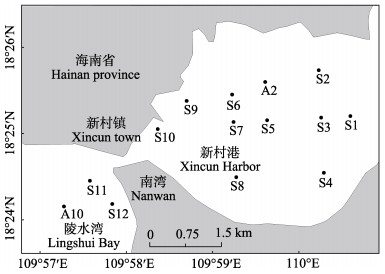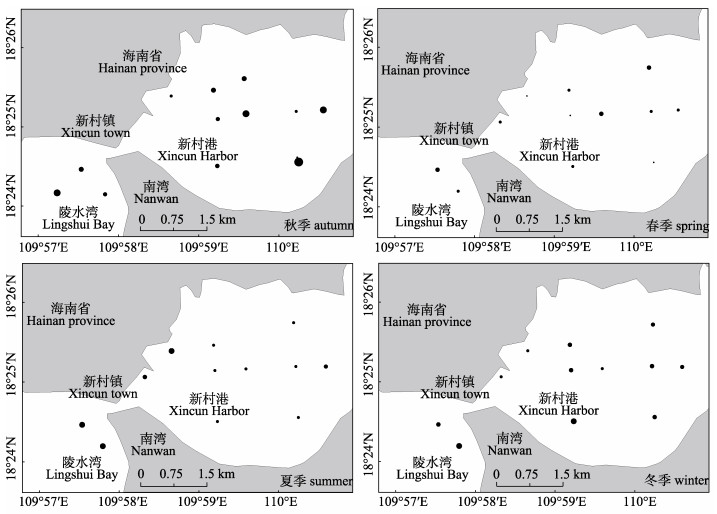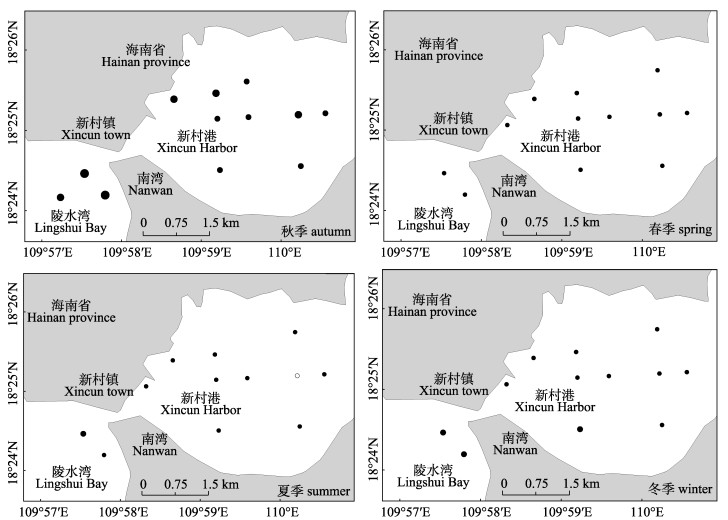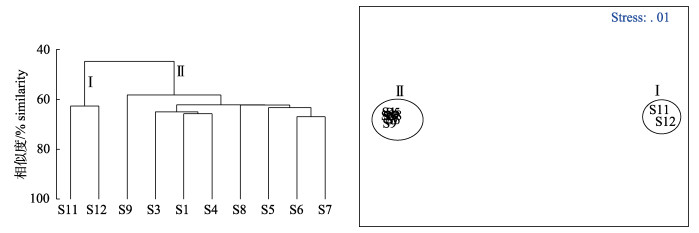陵水湾位于海南东南部海岸, 周围群山环抱, 湾内宽阔, 无明显径流注入, 与湾外仅由一个狭窄的潮汐汊道相通, 是个半封闭的沙坝-潮汐汊道-潟湖海岸体系, 地貌格局复杂, 地形变化较大[1]。海湾周年水温、盐度适中, 适宜养殖, 是国家及海南省的重点渔港之一, 也是海南省重要的网箱养殖和麒麟菜养殖基地。不少学者已对陵水湾水动力特征[1-5]、沉积物[6]和浮游植物[7]等方面做过相关研究, 但对该海湾浮游动物的研究则极少见报道。浮游动物作为海洋次级生产力的主要组成者, 是中、上层鱼类及一切幼鱼的基础饵料, 对鱼、虾、贝类等海洋生物资源变动产生直接或间接影响, 对海洋渔业增产具有重要意义[8]。此外, 浮游动物种类和数量的变化与环境密切相关, 在一定程度上可反映海域环境质量状况[9]。
近几年来, 由于陵水湾新村港内养殖面积激增, 养殖污水、船坞废水及生活污水的大量排放, 导致海域内水质变差, 溶氧率降低, 赤潮及养殖鱼类死亡事故频繁发生。2016年年初, 陵水湾有不少养殖鱼类出现大面积死亡, 养殖户损失巨大。目前, 陵水湾环境与湾内渔业产业的矛盾已日益激显, 合理的养殖密度及健康的养殖水体对陵水湾渔业产业的健康及可持续发展尤为重要。因此, 作者在2014—2016年对海南陵水湾进行了4个季度的浮游动物及其生态环境调查, 对海湾浮游动物的群落结构特征、影响因素等进行分析, 为保护海湾生态环境及海湾渔业产业的可持续发展提供基础资料。
1 材料与方法 1.1 样品采集与分析于2014年11月(秋季), 2015年5月(春季)、8月(夏季)及2016年1月(冬季)分别对陵水湾海域(109°57'15.78"E, 18°24'08.69"N~110°00'38.14"E, 18°25'34.50"N)进行渔业生态资源综合调查(图 1), 结合陵水湾的地理形状、养殖区的现状, 综合考虑当前网箱布局、水流等因素, 一共设置12个调查站位(S1~S9位于湾内、S10位于湾口水道、S11~S12位于湾外)。秋季航次因S2和S10未采到样品, 加采A2和A10以作补充。浮游动物样品使用浅水Ⅰ型浮游生物网(网目孔径0.505 mm, 网口内径50 cm, 网长145 cm)由底至表垂直拖取, 现场福尔马林溶液固定保存, 带回实验室进行分类鉴定、计数及浮游动物湿重生物量的称量; 海水温度(T)和盐度(S)均使用YSI 556 MPS型多功能水质仪现场测定。

|
图 1 陵水湾采样站位示意图 Fig.1 Distribution of sampling stations in Lingshui Bay |
各参数按下列公式计算:
优势度[10]
| $Y = ({n_i}/N) \times {f_i} $ |
Shannon-Wiener多样性指数[11]
| $H\mathit{'= - }\sum\limits_{i = 1}^s {{p_i}\;{{\log }_2}\;{p_\mathit{i}}} $ |
均匀度[12]
| $J = H'/(\rm{log}{_2}\mathit{S}) $ |
| $F = [b \cdot V \cdot (P{\rm{/}}B) \cdot a]/E $ |
式中, F为浮游动物渔产潜力(kg), b为浮游动物年均生物量(kg/hm2), V表示陵水湾新村港内水域面积与水深的乘积(24 hm2×5.8 m), P/B指主要饵料生物现存量与生物量之间的比值(50), a为浮游动物食性鱼类对浮游动物饵料的利用率(50%), E为饵料系数(10)。
运用PRIMER5.2软件, 对浮游动物群落结构进行聚类分析和非度量多维标度排序NMDS(non- metrimulti-dimensional scaling)分析。为减少机会种对群落结构的干扰, 浮游动物丰度数据经4次方根转化后, 建立样品间的Bray-Curtis相似性矩阵, 进行组间平均聚类(group average cluster)和非度量多维标度排序, 并做相似性分析(ANOSIM)检验[15-16]。
2 结果与分析 2.1 种类组成及季节变化陵水湾4个季节共发现94种浮游动物, 分类学上隶属于16大类群, 其中桡足类种类数最多, 有38种, 占总种数的40.43%, 其次是水螅水母类, 11种, 占总种数的11.70%;毛颚类8种, 占总种数的8.51%;其余类群种类相对较少, 种类数在1~6种之间(表 1)。此外, 该次调查还发现浮游幼虫21类, 其中10类为底栖生物浮游幼虫。
|
|
表 1 陵水湾浮游动物种类组成 Tab.1 The species composition of zooplankton in Lingshui Bay |
浮游动物群落种类组成存在季节变化, 夏季(61种)种类最丰富, 占全年出现浮游动物种类数的64.89%, 湾外出现大量广布暖水外海种, 种类数分布呈现由湾外向湾内递减趋势; 其次是秋季(43种), 种类数占全年出现浮游动物种类数的45.74%, 且湾外高于湾内, 浮游幼体19类, 于全年最高; 冬季种类数(29种)略高于春季(25种), 分别占全年出现浮游动物种类数的30.85%和26.60%, 呈不规则分布。
2.2 优势种及季节变化调查期间, 该海域共出现10种优势种(未包括浮游幼虫), 无全年优势种, 红住囊虫(Oikopleura rufescens)、长尾住囊虫(Oikopleura longicauda)、红纺锤水蚤(Acartia erythraea)和鸟喙尖头溞(Penilia avirostris)在其中3个季度均成为优势种(表 2)。
|
|
表 2 陵水湾浮游动物优势种 Tab.2 Dominant species of zooplankton in Lingshui Bay |
秋季浮游动物仅以有尾类占优势, 其中红住囊虫优势度高达0.43;其余季节浮游动物优势种主要由有尾类、桡足类和枝角类组成, 但也出现特有优势种:春季为球形侧腕水母(Pleurobachia globosa)和厦门矮隆哲水蚤(Bestiola amoyensis), 夏季为肥胖箭虫(Sagitta enflata), 冬季为夜光虫(Nocitiluca scintillans)。除秋季外, 各季节浮游动物优势种的季节演替不太明显。
2.3 丰度和生物量的变化陵水湾浮游动物年均丰度为132.47 ind/m3, 秋季(335.29 ind/m3)最高, 且密集分布在湾内的S7和湾外的S12。春季浮游动物丰度(38.20 ind/m3)最低, 冬季(79.33 ind/m3)略高于夏季(77.09 ind/m3), 各季节浮游动物丰度的平面分布相对均匀(图 2)。

|
图 2 各个季节陵水湾浮游动物丰度的平面分布 Fig.2 Horizontal distributions of zooplankton abundance in Lingshui Bay in different seasons |
有尾类是陵水湾浮游动物群落的全年优势类群, 年均丰度为49.99 ind/m3, 居首位。有尾类密度以秋季最高, 主要密集分布在S7站位(1193.33 ind/m3), 以红住囊虫和异体住囊虫(Oikopleura dioica)占有绝对优势(1073.33 ind/m3和120.00 ind/m3), 其他季节丰度较低, 分布相对均匀。浮游幼体年均丰度为32.18 ind/m3, 仅次于有尾类居第2位, 秋季丰度最高(51.71 ind/m3), 为该季丰度第三大类群, 其余季节平均丰度在16.88~32.08 ind/m3, 占各季节浮游动物总丰度的35.38%~44.20%, 是各季节浮游动物丰度最大的一个类群。桡足类种类最多, 但数量不突出, 其丰度在各季节均处于次高水平。枝角类丰度不高, 但在全年均占有一定优势, 湾内外均有分布(图 3)。

|
图 3 陵水湾浮游动物主要类群的季节变化 Fig.3 Seasonal variation of main groups of zooplankton in Lingshui Bay |
陵水湾浮游动物生物量的季节变化与丰度的季节变化相似, 均以秋季最大(76.04 mg/m3), 春季最低(2.28 mg/m3), 冬季(8.18 mg/m3)高于夏季(4.73 mg/m3)。湾内浮游动物生物量趋于稳定, 总体比湾外低(图 4)。

|
图 4 各个季节陵水湾浮游动物生物量的平面分布 Fig.4 Horizontal distributions of zooplankton biomass in Lingshui Bay in different seasons |
浮游动物群落空间聚类分析结果表明(图 5), 陵水湾浮游动物可分为2个群落类型, 分别为湾外的群落Ⅰ和湾内的群落Ⅱ, 两群落相似度为44.76%。ANOSIN差异性检验表明, 群落Ⅰ和群落Ⅱ差异显著, R值为0.22(P<0.05)。

|
图 5 陵水湾各站位间的浮游动物相似性聚类及标序 Fig.5 CLUSTER and MDS ordination of zooplankton at different survey stations in Lingshui Bay |
浮游动物群落季节聚类分析显示(图 6), 陵水湾夏季和冬季浮游动物群落相似性最高, 相似度为56.27%, 与春季可归为同一类群落A, 相似度为51.34%;秋季自成另一类群落B, 与群落A的相似度仅有27.92%。ANOSIN群落间的差异性检验表明, R值为0.917, 两群落差异极显著(P<0.001)。

|
图 6 陵水湾各季节间的浮游动物相似性聚类及标序 Fig.6 CLUSTER and MDS ordination of zooplankton in different seasons Lingshui Bay |
陵水湾浮游动物多样性指数(H')年均值为3.42, 秋季最低且站位间变化最大, 其他季节均高于3.00;均匀度(J)年均值为0.83, 春季最高(0.92), 秋季最低(0.70)。湾内浮游动物生物多样性总体低于湾外, 且各站位出现不同程度的变化(表 3)。
|
|
表 3 陵水湾浮游动物的生物多样性指数 Tab.3 Biodiversity index of zooplankton in Lingshui Bay |
浮游动物与环境因子间的Pearson相关性系数见表 4。浮游动物丰度和生物量均与盐度呈显著负相关(P<0.05), 浮游动物生物量还与DO呈显著负相关(P<0.05);其余浮游动物类群丰度与表 4所列生态因子均没有统计学意义相关性。
|
|
表 4 陵水湾浮游动物与环境因子的相关关系 Tab.4 Pearson correlation between zooplankton and environmental factors in Lingshui Bay |
调查期间, 陵水湾共发现浮游动物94种和浮游幼虫21类。其中, 桡足类最多(38种), 占总种类数的40.43%, 是该海湾浮游动物的重要类群, 与国内大多数海域[17-20]的结果相似。陵水湾浮游幼虫较多, 包括永久性幼虫(桡足类幼虫、毛颚类幼虫、莹虾类幼虫等8类)和阶段性幼虫(长尾类幼虫、短尾类幼虫、多毛类幼虫等12类), 全年均有出现且丰度较高, 占浮游动物总丰度比重较大。根据以往对南海北部海域浮游幼虫的调查发现, 三亚湾浮游幼虫[21-23]全年均呈高丰度出现, 其中冬季丰度高于或接近其他季节; 广东沿岸海域[17, 24-26]也显示了其重要地位, 但丰度出现明显季节变化, 表现为高温季节高于低温季节; 北部湾海域[27]也常年出现浮游幼虫, 丰度由高到低依次为夏季、春季、秋季、冬季, 认为水温是影响其丰度高低的主要因素之一。陵水湾与三亚湾均位于海南南部, 属热带气候, 全年温度较高, 两海湾浮游幼虫全年的高丰度出现说明, 两个海湾的海洋生物一年四季均可大量繁殖, 低温已不再是他们生长繁殖的主要限制因子。而对于亚热带气候的广东沿岸及北部湾而言, 浮游幼虫丰度表现出季节变化, 明显受温度影响, 冬季丰度最低, 说明在亚热带气候海域海洋生物的繁殖仍受低温影响, 与热带海域表现出明显的不同。
有尾类是陵水湾浮游动物唯一的全年优势类群, 在浮游动物群落中占有重要的数量地位。陵水湾有尾类主要包括红住囊虫、异体住囊虫和长尾住囊虫, 这3个种类在三亚湾等海南近岸海域[18, 21-22]浮游动物群落中常占有一定优势, 在广东沿岸海域的夏秋季也偶尔形成优势[17], 但优势度不高。徐兆礼等[28]对东海浮游动物的研究发现, 有尾类在东海全年均有出现, 异体住囊虫和长尾住囊虫能适应更广泛的温度和盐度, 出现率较高, 而红住囊虫属高温高盐种, 主要分布在高温高盐海区。陵水湾年均温度(28.30℃)和盐度(32.56)都较高, 红住囊虫在陵水湾的高出现率及高丰度符合其生长特性。
陵水湾浮游动物可划分为4个生态类群:河口低盐类群、广温广盐类群、暖水沿岸类群和暖水外海类群。陵水湾河口低盐类群的浮游动物很少, 仅偶尔发现; 广温广盐性类群的浮游动物种类较多, 数量也较大, 除秋季外, 均形成优势; 暖水沿岸性类群种类多、数量大, 是陵水湾浮游动物最重要的优势类群; 暖水外海类群在浮游动物种类组成中也占有较大比重, 但除红住囊虫外, 其余种类数量不大, 均没有形成优势。从浮游动物种类组成看, 陵水湾浮游动物群落主要由广温广盐类群、暖水沿岸类群和暖水外海类群组成, 而从优势种组成看, 陵水湾浮游动物群落则主要由暖水沿岸类群和广温广盐类群组成。
聚类分析显示, 陵水湾浮游动物存在湾内和湾外两个群落, 明显受地形影响所致。陵水湾内外仅由一条狭窄的潮汐汊道相通, 湾内宽阔无明显径流流入, 水体常年处于高盐状态; 湾外面向广阔的南海, 与南海外海水交换频繁, 浮游动物群落与三亚湾[21-22]等开阔海湾相似, 比湾内具有更多的暖水外海种。湾内浮游动物种类较少, 容易出现单个物种的密集性增殖(尤以秋季明显), 生物多样性较低, 浮游动物群落结构变动较大, 稳定性明显较湾外低。同样受地形阻隔, 杭州湾内海域浮游动物种类数和数量均低于湾外, 显示了地形阻隔对浮游动物群落具有重要影响[29]。
3.2 渔产潜力估算早在1981年, 王骥等[30]已利用浮游植物估算了鲢鳙生产潜力并推算其放养量。何志辉等[13]也利用浮游动、植物估算了清河水库的鲢鳙产量。目前更多研究倾向于结合浮游植物、浮游动物、有机碎屑以及底栖动物来估算总的渔产潜力, 以更合理推算出鱼类的放养量[14, 31-33]。根据陵水湾新村港的水域自然状况, 计算出该港湾内浮游动物食性鱼类的渔产潜力为2.24x104 kg。网箱养殖是陵水湾的重要水产养殖方式, 据颜云榕等[34]统计, 陵水湾网箱养殖全年使用天然饲料鱼类5.34万t, 1月份为全年高峰(8436.7 t)。可见, 陵水湾浮游动物食性鱼类的渔产潜力远低于该港湾需投用的天然饵料鱼类的量。但该研究仅分析了浮游动物的渔产潜力, 在往后的研究需要对陵水湾浮游植物、底栖动物及有机碎屑的渔产潜力加以估算, 以更合理准确地评估陵水湾鱼类养殖容量, 也为陵水湾渔业的可持续发展提供参考依据。
3.3 环境因子的影响浮游动物的生长繁殖受其生存环境影响, 而温度和盐度是重要的环境因子, 可影响浮游动物的整个生长繁殖过程以及分布情况[35-39]。陵水湾浮游动物丰度在水温最高的春季最低, 而在水温
最低的冬季相对较高, 相关分析也表明, 浮游动物丰度和生物量均与水温呈现负相关关系。金琼贝等[38]通过室内模拟试验发现, 枝角类、桡足类、无节幼体适宜在20~30℃水温下生长, 当水温超过30℃时, 数量随温度升高而显著降低。陵水湾春季浮游动物及幼体丰度最低, 但温度全年最高(平均31.63℃), 说明很可能出现了高温抑制作用, 而冬季(平均24.97℃)浮游动物及幼体丰度高于春季, 也说明陵水湾海洋生物的生长已不受低温限制, 在高温季节温度主要起抑制作用, 低温季节反而更适于浮游动物的生长繁殖, 与温度对大部分亚热带海域浮游动物产生的高温季节和低温季节均出现限制作用[17, 24-26]不同。
陵水湾浮游动物群落季节聚类分析显示, 秋季浮游动物群落明显与其他季节不同, 主要表现在该季节浮游动物丰度远高于其他季节, 优势种单一。在分析浮游动物丰度和生物量与生态因子的关系时发现, 除与盐度呈显著负相关关系外, 与浮游植物丰度, 叶绿素a浓度、溶解氧、磷酸盐、溶解无机氮等因子基本不存在显著性相关关系。黄加祺等[39]研究九龙江口桡足类和盐度的关系时发现, 沿岸类群浮游动物耐盐范围较广, 可分布在10~31.7之间, 随后其数量随盐度的增加而下降。陵水湾盐度普遍较高, 4个调查航次的盐度平均为31.29、33.68、33.26和32.02, 与浮游动物丰度和生物量呈显著负相关关系, 说明陵水湾浮游动物的季节变化很可能受盐度影响。红住囊虫属暖水外海种, 能适应高盐环境(> 33)[39], 但仅在盐度最低的秋季数量达到最大, 且秋季大部分站位的浮游动物丰度和生物量均高于其他季节, 这说明除盐度外, 还有其他重要因素影响着陵水湾浮游动物的季节变化, 或是在多个重要影响因素共同作用下的结果, 具体原因有待以后探讨。
陵水湾是海南省重要的水产养殖基地, 养殖品种、网箱设施及养殖环境等都会影响浮游动物种类组成和丰度大小[40-43]。而浮游动物作为食物链不可或缺的中间环节, 是食浮游动物鱼类及仔稚鱼的重要饵料; 而作为环境监测指标, 其种类组成和丰度大小可反映水环境健康状况。陵水湾在冬季出现了夜光虫优势种, 虽丰度不大, 但需引起足够重视。夜光虫是一种赤潮生物, 在环境适宜时可大量增殖, 而其在增殖及死亡分解过程中会消耗水中的大量氧气, 导致大量海洋生物缺氧而死, 破坏海域生态系统平衡[44]。如果赤潮发生在养殖区, 可对养殖业造成巨大损失。此外, 陵水湾秋季某些站位的多样性指数和均匀度都很低, 浮游动物多样性差, 显示了该海湾的局部海域出现了不健康水体, 这也需足以重视。因此, 有必要对陵水湾浮游生物及环境要素进行长期的跟踪监测, 以期保证陵水湾水产养殖业的健康可持续发展。
| [1] |
Gong W P, Wang Y P, Wang D R, et al. Hydrodynamics under combined action of wave and tide and its implication for the sediment dynamics in Xincun tidal inlet, Hainan[J]. Journal of Marine Sciences, 2008, 26(2): 1-12. [龚文平, 汪亚平, 王道儒, 等. 海南新村港潮汐汊道波流联合作用下的动力特征及其沉积动力学意义[J]. 海洋学研究, 2008, 26(2): 1-12. DOI:10.3969/j.issn.1001-909X.2008.02.001] |
| [2] |
Gong W P, Shen J, Chen B. Obtaining water elevation in the lagoon and cross-sectionally averaged velocity of the tid-alinlet by using one-dimensional hydraulic equation-a case study in Xincun inlet Linshui, Hainan, China[J]. Journal of Oceanography in Taiwan Strait, 2007, 26(3): 301-313. [龚文平, Shen Jian, 陈斌. 用一维水力学方程求取潟湖水位及潮汐汊道断面流速——以海南陵水新村港为例[J]. 台湾海峡, 2007, 26(3): 301-313. DOI:10.3969/j.issn.1000-8160.2007.03.001] |
| [3] |
Gong W P, Shen J, Wang D R. Mean water level setup/set down in the inlet-lagoon system induced by tidal action-a case study of Xincun Inlet, Hainan Island in China[J]. Acta Oceanologica Sinica, 2008, 27(5): 63-80. |
| [4] |
Gong W P, Chen M H, Wen X J, et al. Evolution and stabil-ity of Xincun tidal inlet, Lingshui county, Hainan province[J]. Journal of Tropical Oceanography, 2004, 23(4): 25-32. [龚文平, 陈明和, 温晓骥, 等. 海南陵水新村港潮汐汊道演变及其稳定性分析[J]. 热带海洋学报, 2004, 23(4): 25-32. DOI:10.3969/j.issn.1009-5470.2004.04.004] |
| [5] |
Gong W P, Wang D R. Stability analysis and equilibrium area calculation of tidal inlet-A case study in Xincun inlet, Lingshui Hainan Island[J]. Journal of Tropical Oceanogra-phy, 2006, 25(4): 31-41. [龚文平, 王道儒. 潮汐汊道均衡断面面积计算与稳定性分析中的问题——以海南陵水新村为例[J]. 热带海洋学报, 2006, 25(4): 31-41. DOI:10.3969/j.issn.1009-5470.2006.04.006] |
| [6] |
Chen S Q, Zhang G X, Wu Z J, et al. The distribution char-acteristics and the pollution evaluation of the heavy metals in the surface sediments of Xincun lagoon[J]. Transactions of Oceanology and Limnology, 2014(4): 144-152. [陈石泉, 张光星, 吴钟解, 等. 新村港表层沉积物重金属分布特征及污染评价[J]. 海洋湖沼通报, 2014(4): 144-152.] |
| [7] |
Han T S, Wan L, Xu X B. Characteristics of the phytoplankton community in Xincun Harbour, Lingshui, Hainan[J]. Journal of Tropical Organisms, 2012, 3(2): 180-185. [韩涛生, 万莉, 许小贝. 海南陵水新村港浮游植物群落特征分析[J]. 热带生物学报, 2012, 3(2): 180-185. DOI:10.3969/j.issn.1674-7054.2012.02.019] |
| [8] |
Zheng Z, Li S J, Xu Z Z. Marine Planktology[M]. Beijing: China Ocean Press, 1984. [郑重, 李少菁, 许振祖. 海洋浮游生物学[M]. 北京: 海洋出版社, 1984.]
|
| [9] |
Zhang C X, Gong Y Y, Sun X L, et al. Zooplankton community in the coastal zone of Leizhou Peninsula in summer 2010[J]. Acta Oceanologica Sinica, 2014, 36(4): 91-99. [张才学, 龚玉艳, 孙省利, 等. 2010年夏季雷州半岛沿岸海域浮游动物群落结构特征[J]. 海洋学报, 2014, 36(4): 91-99. DOI:10.3969/j.issn.0253-4193.2014.04.008] |
| [10] |
Xu Z L, Chen Y Q. Aggregated intensity of dominant species of zooplankton in autumn in the East China Sea and Yellow Sea[J]. Chinese Journal of Ecology, 1989, 8(4): 13-15. [徐兆礼, 陈亚瞿. 东黄海秋季浮游动物优势种聚集强度与鲐鲹渔场的关系[J]. 生态学杂志, 1989, 8(4): 13-15.] |
| [11] |
Shannon C E, Weaver W. The Mathematical Theory of Communication[M]. Urbana IL: University of Illinois Press, 1949.
|
| [12] |
Pielou E C. An Introduction to Mathematical Ecology[M]. New York: Wiley-Interscience, 1969: 1-286.
|
| [13] |
He Z H, Li Y H. Studies on the plankton in Qinhe Reser-voir[J]. Acta Hydrobiologica Sinica, 1983, 8(1): 71-84. [何志辉, 李永函. 清河水库的浮游生物[J]. 水生生物学集刊, 1983, 8(1): 71-84.] |
| [14] |
Ding N. Research of water environment and carring capacity in the west Yangcheng Lake[D]. Nanjing: Nanjing Agricultural University, 2015. [丁娜.阳澄西湖水环境及其养殖容量的研究[D].南京: 南京农业大学, 2015.]
|
| [15] |
Du F Y, Wang X H, Lin Z J. The characteristics of summer zooplankton community in the Meiji Coral Reef, Nansha Is-lands, South China Sea[J]. Acta Ecologica Sinica, 2015, 35(4): 1014-1021. [杜飞雁, 王雪辉, 林昭进. 南沙群岛美济礁海域夏季浮游动物群落特征[J]. 生态学报, 2015, 35(4): 1014-1021.] |
| [16] |
Zhou H, Zhang Z N. Rationale of the multivariate statistical software PRIMER and its application in benthic community ecology[J]. Journal of Ocean University of Qingdao, 2003, 33(1): 58-64. [周红, 张志南. 大型多元统计软件PRIM ER的方法原理及其在底栖群落生态学中的应用[J]. 青岛海洋大学学报, 2003, 33(1): 58-64. DOI:10.3969/j.issn.1672-5174.2003.01.023] |
| [17] |
Jia X P, Li C H, Chen Z Z, et al. Management Strategy of Fishery Resources and Its Ecological System in the Northern South China Sea[M]. Beijing: China Ocean Press, 2012. [贾晓平, 李纯厚, 陈作志, 等. 南海北部近海渔业资源及其生态系统水平管理策略[M]. 北京: 海洋出版社, 2012.]
|
| [18] |
Zhang G X, Chen S Q, Chen D D, et al. The relationship between zooplankton and the environment factors in the coastal waters of Hannan Island in the early summer[J]. Acta Oceanologica Sinica, 2014, 36(12): 125-132. [张光星, 陈石泉, 陈丹丹, 等. 海南岛近岸海域夏初浮游动物与环境因子的关系[J]. 海洋学报, 2014, 36(12): 125-132. DOI:10.3969/j.issn.0253-4193.2014.12.013] |
| [19] |
Shao Q W, Liu Z S, Zhang J, et al. Seasonal variation in zooplankton community structure in the Changjiang Estuary and its adjacent waters[J]. Acta Ecologica Sinica, 2017, 37(2): 683-691. [邵倩文, 刘镇盛, 章菁, 等. 长江口及邻近海域浮游动物群落结构及季节变化[J]. 生态学报, 2017, 37(2): 683-691.] |
| [20] |
Luo X, Zeng J N, Xu X Q, et al. Distribution of zooplankton in the Zhoushan Sea and its relationship with environmental factors in summer and autumn[J]. Acta Ecologica Sinica, 2016, 36(24): 8194-8204. [骆鑫, 曾江宁, 徐晓群, 等. 舟山海域夏、秋季浮游动物的分布特征及其与环境因子的关系[J]. 生态学报, 2016, 36(24): 8194-8204.] |
| [21] |
Yin J Q, Zhang G X, Tan Y H, et al. Species composition and quantitative distribution of zooplankton in Sanya Bay, Hainan Province, China[J]. Journal of Tropical Oceanogra-phy, 2004, 23(5): 1-9. [尹健强, 张谷贤, 谭烨辉, 等. 三亚湾浮游动物的种类组成与数量分布[J]. 热带海洋学报, 2004, 23(5): 1-9. DOI:10.3969/j.issn.1009-5470.2004.05.001] |
| [22] |
Shi X, Wang H K, Tan Y H, et al. Seasonal variation of zooplankton community structure and species composition in the Sanya Bay[J]. Marine Science Bulletin, 2007, 26(4): 42-49. [时翔, 王汉奎, 谭烨辉, 等. 三亚湾浮游动物数量分布及群落特征的季节变化[J]. 海洋通报, 2007, 26(4): 42-49. DOI:10.3969/j.issn.1001-6392.2007.04.005] |
| [23] |
Ke Z X, Huang L M, Tan Y H, et al. Plankton community structure and diversity in coral reefs area of Sanya Bay, Hainan Province, China[J]. Biodiversity Science, 2011, 19(6): 696-701. [柯志新, 黄良民, 谭烨辉, 等. 三亚珊瑚礁分布海区浮游生物的群落结构[J]. 生物多样性, 2011, 19(6): 696-701.] |
| [24] |
Zhang C X, Zhou K, Sun X L, et al. Community structure and seasonal variation of the zooplankton in Shenzhen Bay[J]. Ecology and Environmental Sciences, 2010, 19(11): 2686-2692. [张才学, 周凯, 孙省利, 等. 深圳湾浮游动物的群落结构及季节变化[J]. 生态环境学报, 2010, 19(11): 2686-2692. DOI:10.3969/j.issn.1674-5906.2010.11.029] |
| [25] |
Zhang C X, Sun X L, Chen C L, et al. Community structure and seasonal changes of the zooplankton in the seaweed-field area of the Liusha bay[J]. Oceanologia et Limnologia Sinica, 2013, 44(5): 1386-1394. [张才学, 孙省利, 陈春亮, 等. 流沙湾海草床海域浮游动物的群落结构和季节变化[J]. 海洋与湖沼, 2013, 44(5): 1386-1394.] |
| [26] |
Gong Y Y, Chen Z Z, Huang Z R. Comparative analysis on community structure of zooplankton in different sea areas of Guangdong seacoast[J]. Journal of Southern Agriculture, 2015, 46(11): 2026-2033. [龚玉艳, 陈作志, 黄梓荣. 广东沿岸不同海域浮游动物群落结构的比较分析[J]. 南方农业学报, 2015, 46(11): 2026-2033. DOI:10.3969/j:issn.2095-1191.2015.11.2026] |
| [27] |
Wang X F, Li C H, Liao X L, et al. Community structure and environmental adaptation of the planktonic larvae in Beibu Gulf[J]. Journal of Shanghai Ocean University, 2010, 19(4): 529-534. [王学锋, 李纯厚, 廖秀丽, 等. 北部湾浮游幼虫群落结构及其环境适应性分析[J]. 上海海洋大学学报, 2010, 19(4): 529-534.] |
| [28] |
Xu Z L, Zhang F Y. Species distribution and diversity of Appendicularia in the East China Sea[J]. Journal of Shanghai Fisheries University, 2006, 15(3): 286-291. [徐兆礼, 张凤英. 东海有尾类种类分布和多样性[J]. 上海水产大学学报, 2006, 15(3): 286-291.] |
| [29] |
Zhang D R, Xu Z L, Xu J Y. Comparison of zooplankton communities inside and outside the Hangzhou Bay in au-tumn[J]. Biodiversity Science, 2016, 24(7): 767-780. [张冬融, 徐兆礼, 徐佳奕, 等. 杭州湾内外海域秋季浮游动物群落的比较[J]. 生物多样性, 2016, 24(7): 767-780.] |
| [30] |
Wang J, Liang Y L. An estimation of the potential produc-tivity and stocking rate of fingerlings of silver and bighead carps in Donghu by means of phytoplankton production[J]. Journal of Fisheries of China, 1981, 5(4): 343-350. [王骥, 梁彦龄. 用浮游植物的生产量估算武昌东湖鲢鳙生产潜力与鱼种放养量的探讨[J]. 水产学报, 1981, 5(4): 343-350.] |
| [31] |
Chang Y. Research of eutrophication and fishery utilizationin in Changyang Lake, Wujiang, Jiangsu Province[D]. Wuhan: Huazhong Agricultural University, 2013. [常毅.江苏吴江市长漾湖富营养化与渔业利用研究[D].武汉: 华中农业大学, 2013.]
|
| [32] |
He W. The assess of fishery ecological environment and countermeasures of resources enhancement in lake Chang-dang[D]. Nanjing: Nanjing Agricultural University, 2015. [何玮.长荡湖渔业生态环境评估及资源增殖对策[D].南京: 南京农业大学, 2015.]
|
| [33] |
Li X Z. Current situation, problems and countermeasures of fishery resources in Hongze Lake[D]. Nanjing: Nanjing Agricultural University, 2015. [李孝珍.洪泽湖渔业资源现状、问题及对策[D].南京: 南京农业大学, 2015.]
|
| [34] |
Yan Y R, Zhu G S, Zhang Y M, et al. The impacts of natural fishes as cage culture feeds on fishery resources in South China Sea-taking Lingshui Port for example[C]//Abstracts Collection at the Annual Academic Meeting of the Chinese Society of Fisheries, 2013: 164. [颜云榕, 朱高松, 张宇美, 等.天然鱼类作为网箱养殖饲料对南海渔业资源的影响——以海南陵水湾为例[Z].中国水产学会学术年会论文摘要集, 2013: 164.]
|
| [35] |
Guo P Y, Shen H T, Liu A C, et al. Factors controlling abundance and distribution of mesozooplankton and microzooplankton in Yangtze River Estuary[J]. Acta Ecologica Sinica, 2008, 28(8): 3517-3526. [郭沛涌, 沈焕庭, 刘阿成, 等. 长江河口中小型浮游动物数量分布、变动及主要影响因素[J]. 生态学报, 2008, 28(8): 3517-3526. DOI:10.3321/j.issn:1000-0933.2008.08.004] |
| [36] |
Lin L M, Xu F, Lin J. Effects of various salinities to growth and development of Acartia spinicauda[J]. Journal of Oceanography in Taiwan Strait, 1998, 17(S1): 53-55. [林利民, 许峰, 林君. 盐度对刺尾纺锤水蚤生长发育的影响[J]. 台湾海峡, 1998, 17(S1): 53-55.] |
| [37] |
Jiang H C, Chen H G, Song X K, et al. Zooplankton com-munity structure in Jincheng area of Laizhou Bay and its re-lationship with environmental factors[J]. Acta Ecologica Sinica, 2015, 35(22): 7308-7319. [姜会超, 陈海刚, 宋秀凯, 等. 莱州湾金城海域浮游动物群落结构及与环境因子的关系[J]. 生态学报, 2015, 35(22): 7308-7319.] |
| [38] |
Jin Q B, Sheng L X, Zhang R. The influence of temperature on the zooplankton community[J]. Journal of Northeast Normal University, 1991(4): 103-111. [金琼贝, 盛连喜, 张然. 温度对浮游动物群落的影响[J]. 东北师大学报自然科学版, 1991(4): 103-111.] |
| [39] |
Huang J Q, Zheng Z. The relation of copepods to salinity in the estuary of Jiulong river[J]. Journal of Xiamen University (Natural Science), 1984, 23(4): 497-505. [黄加祺, 郑重. 九龙江口桡足类和盐度关系的初步研究[J]. 厦门大学学报(自然科学版), 1984, 23(4): 497-505. DOI:10.3321/j.issn:0438-0479.1984.04.012] |
| [40] |
Jiang S, Huang C J, Chen S W, et al. Community structure and temporal and spatial distribution of zooplankton in Zhelin Bay, China (2000~2001)[J]. Acta Ecologica Sinica, 2002, 22(6): 828-840. [姜胜, 黄长江, 陈善文, 等. 2000~2001年柘林湾浮游动物的群落结构及时空分布[J]. 生态学报, 2002, 22(6): 828-840. DOI:10.3321/j.issn:1000-0933.2002.06.006] |
| [41] |
Huang C J, Chen S W, He X, et al. Ecological study of zoo-plankton in Zhenlin Bay of eastern Guangdong:2001- 2002[J]. Oceanologia et Limnologia Sinica, 2003, 34(2): 117-130. [黄长江, 陈善文, 何歆, 等. 2001-2002年粤东柘林湾浮游动物的生态学研究[J]. 海洋与湖沼, 2003, 34(2): 117-130. DOI:10.3321/j.issn:0029-814X.2003.02.001] |
| [42] |
Zhou K. Ecological studies on the large-scale mariculture in Zhelin bay and Shen'ao bay in the east of Guangdong: 2000-2001[D]. Guangzhou: Jinan University, 2002. [周凯. 2000~2001年粤东大规模增养殖区柘林湾和深澳湾的生态学研究[D].广州: 暨南大学, 2002.]
|
| [43] |
Liu Z H. Community characteristics of zooplankton in the mariculture area of Aotou, Daya Bay[D]. Guangzhou: Jinan University, 2006. [刘中华.大亚湾澳头养殖海域浮游动物群落结构特征[D].广州: 暨南大学, 2006.]
|
| [44] |
Huang W J, Qi Y Z, Zhu C J, et al. Model of changing ratio of the population densities dynamics of Noctiluca scintillans (Ehr.) macartney in Dapeng Bay, South China Sea[J]. Oceanologia et Limnologia Sinica, 1996, 27(1): 29-33. [黄伟建, 齐雨藻, 朱从举, 等. 大鹏湾夜光藻种群密度变化率动态模型研究[J]. 海洋与湖沼, 1996, 27(1): 29-33. DOI:10.3321/j.issn:0029-814X.1996.01.006] |
 2019, Vol. 26
2019, Vol. 26

